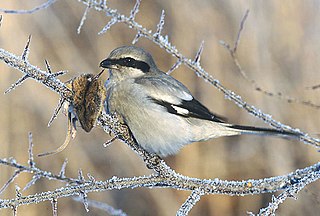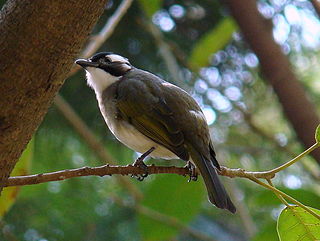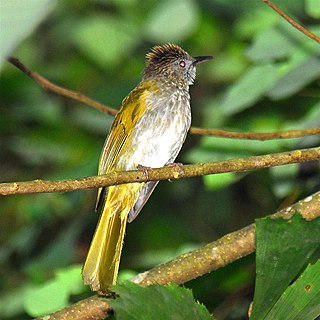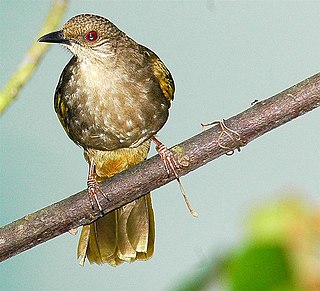
The bulbuls are a family, Pycnonotidae, of medium-sized passerine songbirds, and includes the greenbul, brownbul, leaflove, and bristlebill. The family is distributed across most of Africa and into the Middle East, tropical Asia to Indonesia, and north as far as Japan. A few insular species occur on the tropical islands of the Indian Ocean. There are over 150 species in 27 genera. While different species are found in a wide range of habitats, the African species are predominantly found in rainforest, whereas Asian bulbuls are predominantly found in more open areas.

Plasmodium is a genus of unicellular eukaryotes that are obligate parasites of vertebrates and insects. The life cycles of Plasmodium species involve development in a blood-feeding insect host which then injects parasites into a vertebrate host during a blood meal. Parasites grow within a vertebrate body tissue before entering the bloodstream to infect red blood cells. The ensuing destruction of host red blood cells can result in disease, called malaria. During this infection, some parasites are picked up by a blood-feeding insect, continuing the life cycle.

The red-whiskered bulbul, or crested bulbul, is a passerine bird found in Asia. It is a member of the bulbul family. It is a resident frugivore found mainly in tropical Asia. It has been introduced in many tropical areas of the world where populations have established themselves. It feeds on fruits and small insects. Red-whiskered bulbuls perch conspicuously on trees and have a loud three or four note call. They are very common in hill forests and urban gardens within their range.

The red-vented bulbul is a member of the bulbul family of passerines. It is a resident breeder across the Indian subcontinent, including Sri Lanka extending east to Burma and parts of Tibet. It has been introduced in many other parts of the world and has established itself in the wild on several Pacific islands including Fiji, Samoa, Tonga and Hawaii. It has also established itself in parts of the United Arab Emirates, Bahrain, the United States and Argentina. It is included in the list of the world's 100 worst invasive alien species.

Solanum mauritianum is a small tree or shrub native to South America, including Northern Argentina, Southern Brazil, Paraguay and Uruguay. It has become a widespread invasive weed in Azores Islands, Cook Islands, Fiji, Hawai‘i, New Caledonia, Norfolk Island, Solomon Islands, Tonga, Réunion Island, Mauritius, Madagascar, Australia, New Zealand, India, Sri Lanka and several southern African countries. Its common names include earleaf nightshade, woolly nightshade, flannel weed, bugweed, tobacco weed, tobacco bush, wild tobacco and kerosene plant.

Lanius, the typical shrikes, are a genus of passerine birds in the shrike family Laniidae. The majority of the family's species are placed in this genus. The genus name, Lanius, is derived from the Latin word for "butcher", and some shrikes are also known as "butcher birds" because of their feeding habits. The common English name "shrike" is from Old English scríc, "shriek", referring to the shrill call.

The light-vented bulbul is a species of bird in the bulbul family. It is found in central and southern China, northern Vietnam and Taiwan.

Nesocodon is a monotypic genus of flowering plants within the family Campanulaceae. The sole species is Nesocodon mauritianus, formerly known as Wahlenbergia mauritiana, which is endemic to the island of Mauritius.
Novyella is a subgenus of the genus Plasmodium - all of which are parasites. The subgenus was created in 1963 by Corradetti et al.. Species in this subgenus infect birds. It unites the avian malaria parasites with small erythrocytic meronts and elongated gametocytes.
Plasmodium relictum is a species in the genus Plasmodium, subgenus Haemamoeba.

The Cape bulbul is a member of the bulbul family of passerine birds. It is an endemic resident breeder in coastal bush, open forest, gardens and fynbos in western and southern South Africa. This species nests mainly in the southern spring from September to November. The nest is thick walled cup concealed by foliage in a small tree or shrub.

The yellow-whiskered greenbul or yellow-whiskered bulbul is a species of the bulbul family of passerine birds. It is found in western and central Africa.

Ixos is a genus of songbirds in the bulbul family, Pycnonotidae.

Pycnonotus is a genus of songbird in the bulbul family (Pycnonotidae).

The scaly-breasted bulbul is a species of songbird in the bulbul family. It is found from the Malay Peninsula to Borneo. Its natural habitat is subtropical or tropical moist lowland forests. It is threatened by habitat loss.

The flame-throated bulbul is a member of the bulbul family of passerine birds and the state bird of Goa. It is found only in the forests of the Western Ghats in southern India. Formerly included as a subspecies of Pycnonotus flaviventris it has since been elevated to the status of a full species. They are olive backed with yellow undersides, a triangular orange-red throat and a white iris that stands out against the contrasting black head. They are usually seen foraging in groups in the forest canopy for berries and small insects. They have a call often with two or three tinkling notes that can sound similar to those produced by the red-whiskered bulbul. The species has been referred to by names in the past such as ruby-throated bulbul and black-headed bulbul, but these are ambiguous and could apply to other species such as Rubigula flaviventris and R. dispar.
Plasmodium globularis is a parasite of the genus Plasmodium subgenus Novyella. As in all Plasmodium species, P. globularis has both vertebrate and insect hosts. The vertebrate hosts for this parasite are birds.
Plasmodium multivacuolaris is a parasite of the genus Plasmodium subgenus Novyella

Haemoproteus is a genus of alveolates that are parasitic in birds, reptiles and amphibians. Its name is derived from Greek: Haima, "blood", and Proteus, a sea god who had the power of assuming different shapes. The name Haemoproteus was first used in the description of Haemoproteus columbae in the blood of the pigeon Columba livia by Kruse in 1890. This was also the first description of this genus. Two other genera — Halteridium and Simondia — are now considered to be synonyms of Haemoproteus.














